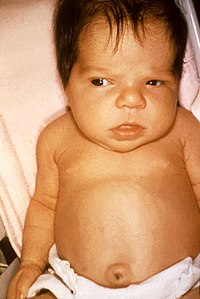
Photo from wikipedia
Introduction UK screening for congenital hypothyroidism (CH) is based on dried blood spot Thyroid Stimulating Hormone (TSH). Scintigraphy may identify CH subtypes classified as dysplasia, gland in situ (GIS) and… Click to show full abstract
Introduction UK screening for congenital hypothyroidism (CH) is based on dried blood spot Thyroid Stimulating Hormone (TSH). Scintigraphy may identify CH subtypes classified as dysplasia, gland in situ (GIS) and ectopia, but is not performed in all centres. We retrospectively investigated the role of scintigraphy to identify CH subtypes in a single tertiary centre cohort. Methods Babies who screened positive for CH between 2007 and 2017 were studied (n=418 of 534 783). Scintigraphy outcomes were correlated with TSH and levothyroxine dose. GIS patients were analysed for 3-year outcomes. Results 303 patients started levothyroxine. Scintigraphy demonstrated three subtypes: GIS (n=139, 46%) ectopia (n=84, 28%) and dysplasia (n=80, 26%). Three-year follow up demonstrated permanence in 54% of 37 GIS cases. Discussion Thyroid scintigraphy differentiates subtypes of CH and suggests a higher than expected proportion of patients with GIS and ectopia. CH is permanent in half of those with GIS.
Journal Title: Archives of Disease in Childhood
Year Published: 2019
Link to full text (if available)
Share on Social Media: Sign Up to like & get
recommendations!